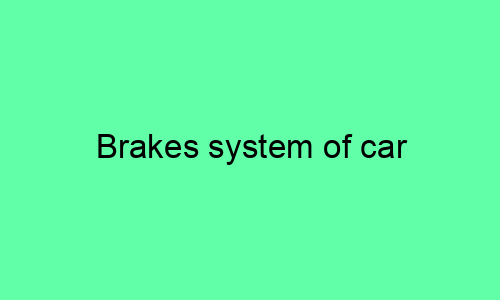Contents
Braking System of a Car
Introduction
The braking system of a car is a critical safety feature that allows drivers to control the vehicle’s speed and bring it to a stop. It consists of several components that work together to convert the driver’s input into a controlled reduction of the car’s speed.
Components of a Braking System
- Brake pedal: The brake pedal is the primary point of contact between the driver and the braking system. When the driver presses on the pedal, it activates the master cylinder.
- Master cylinder: The master cylinder is a hydraulic cylinder that receives the force from the brake pedal and converts it into hydraulic pressure.
- Brake lines: The brake lines are flexible tubes that transmit the hydraulic pressure from the master cylinder to the wheels.
- Wheel cylinders: The wheel cylinders are hydraulic cylinders located at each wheel. They receive the hydraulic pressure from the brake lines and convert it into mechanical force.
- Brake shoes or pads: The brake shoes or pads are friction materials that make contact with the brake rotor or drum to create friction and slow down the vehicle.
- Brake rotors or drums: The brake rotors or drums are metal discs or cylinders that are attached to the wheels. They provide a surface for the brake shoes or pads to rub against, creating friction.
How a Braking System Works
- When the driver presses on the brake pedal, the brake pedal activates the master cylinder.
- The master cylinder converts the force from the brake pedal into hydraulic pressure.
- The hydraulic pressure is transmitted through the brake lines to the wheel cylinders.
- The wheel cylinders convert the hydraulic pressure into mechanical force, pushing the brake shoes or pads against the brake rotors or drums.
- The friction between the brake shoes or pads and the brake rotors or drums slows down the wheels and ultimately the vehicle.
Types of Braking Systems
- Drum brakes: Drum brakes use brake shoes that press against the inside of a metal drum attached to the wheel. Drum brakes are less common in modern cars.
- Disc brakes: Disc brakes use brake pads that press against a metal disc attached to the wheel. Disc brakes are more common in modern cars because they provide better stopping power and heat dissipation.
- Anti-lock Braking System (ABS): ABS is a safety feature that prevents the wheels from locking up during braking. ABS uses sensors to monitor wheel speed and automatically releases and reapplies brake pressure to prevent the wheels from skidding.
Maintaining a Braking System
Regular maintenance is essential for ensuring the proper function of a braking system. Here are some tips for maintaining your car’s braking system:
- Check brake fluid levels regularly.
- Inspect brake pads and shoes for wear.
- Have the brakes inspected and serviced by a mechanic as recommended in the vehicle’s owner’s manual.
- Avoid hard braking whenever possible.
Conclusion
The braking system of a car is a vital safety feature that enables drivers to control the vehicle’s speed and bring it to a stop. By understanding the components, operation, and maintenance of the braking system, you can help ensure that your car is always ready to stop safely.






